The State of Convention Accessibility- Part 1: Baltimore Comic-Con
Convention accessibility has come a long way since the days when we were lucky if there weren’t stairs blocking off the entrance. Attendees can ask for (and sometimes even get) ASL interpreters, aide badges, dedicated chair and scooter seating, and other services to help make the convention experience easier.
Every convention is different, though, and the level of accessibility varies wildly. We took a look at three 2019 conventions of different sizes and locations to see how each handles ADA needs, where they shine, and where they have farther to go.
First up is Baltimore Comic-Con, set near Inner Harbor in Baltimore, Maryland. BCC was the smallest convention we looked at this year for a reason. Convention accessibility is important, but it’s not fair to compare large-budget conventions with events still struggling to get funded every year.
That’s not to say I’m giving those smaller cons a free pass. Every convention can create a good experience for all guests with the right preparation. Organizers at every level need to consider bringing on ADA-savvy consultants standard operating procedure.
That said, let’s take a look at how BCC rates when it comes to convention accessibility.
Location
Baltimore Comic-Con has been held at the Baltimore Convention Center since 2002. Though convention organizers are coy when it comes to releasing exact attendance numbers, around 15,000 people made it to the 2019 show.
The center itself has a bright, inviting feel. I think it’s probably the best place in the area to hold the convention, even if there were major scheduling problems.
“Major” might be an understatement. Maybe I should say “catastrophic”. Somehow BCC ended up from October 18 through the 20th- the exact same weekend as the Baltimore Running Festival. The Marathon was Saturday, which is traditionally the busiest day of a comic con.
Worse yet, the race ended in front of the convention center. Con-goers had to navigate crowds, police, the recovery and first aid areas, and the roped-off race route itself.
That led to confusion with pre-race events Friday and an absolute mess on Saturday. There was only one avenue of approach that avoided the race route, and it wasn’t publicized on the BCC website or social media. I spent over an hour just trying to get inside that day.
I got to say, it’s ridiculous that the #baltimorecomiccon isn’t making proper arrangements for people to be able to get inside around the marathon this morning. I am passing tons of cosplayers wandering as confused as I am.
— The Geekiary (@TheGeekiary) October 19, 2019
No one- not the police, not race personnel, not convention staff that I asked the day before- knew how to get around the race. I can’t understate the level of chaos involved.
When I say I spent an hour trying to get in, I mean I was trying that entire hour. At one point I had to cross a blocked-off highway and climb over a steep median because the alternative was walking another 20 minutes out of the way (I’m slow and there were crowds, okay?).
By the time I got into the convention I was in so much pain I had to take a break, and I hadn’t done anything yet. My mobility problems are just a bad back and nerve damage, too. I hate to think how people with more severe issues managed.
There was a drop-off area for wheelchair users, though it was enormously hard to find. I don’t know how anyone would without prior knowledge. I didn’t see a lot of chairs on Saturday, so maybe most people saw the chaos and decided to skip that day.
Those who didn’t skip found a very light panel schedule. Organizers had to move most of their big-name panels (Greg Cipes and Tara Strong, for example) to Sunday. They did keep the amazing Jim Lee on Saturday, so there was something to reward the persistent.
Maybe convention organizers didn’t have a choice about the race conflict. There were so many things BCC could have done to work with this situation, though. Just off the top of my head:
- Maps prominently featured on the website
- Signage near parking areas and near the race
- Social media notices run Friday and Saturday with ADA access routes
- Volunteers with sandwich boards or big signs
- Giving race personnel and security maps that highlight access routes
Most of these solutions are extremely low-cost. I saw none of them in effect. What a shame.
Parking
The convention put out a lot of information on parking beforehand. This was one of the few times I thought they did a good job with awareness about possible race complications. One trip to the website and you could find all the parking options within a walkable distance.
You may have seen a tiny issue here: a walkable distance. Wheelchair and mobility device users who came alone had a serious trek to the door that involved a lot of urban obstacles. There was a nice sheltered drop-off area that was easy to get to outside of Race Day, so that was nice.
Being downtown had one benefit for low-vision guests: every traffic light from the garage and bus routes to the convention center had the audible pedestrian signals. That’s not always a given, especially in historic areas, so I was glad to hear them.
Taken as a whole, the parking was no better or worse than at other downtown conventions. I’m giving the convention accessibility bonus points for how much information was provided ahead of time.
Layout
BCC doesn’t fill the entire center (yet, at least). It was limited to one side of the convention center, with events held on the upper two floors and the exhibit floor in the basement. There were stairs and escalators to the upper floors and basement.
However, there was one elevator. One.
The center has more elevators, of course, but those were in the area used by the Running Festival events. A single elevator was the only way for BCC visitors to reach the basement exhibit floor.
Upstairs, a second elevator went between the top floors. ADA guests still had to take the single elevator to the ticketing area, but once there they had more options.
Aside from the elevator issue (which is a BIG ONE), the layout was actually pretty ADA friendly. Aisles were wide to allow chair users to browse without blocking traffic (or service dog handlers to keep their pups in front of them while chatting with artists).
There were plenty of ADA bathrooms. I saw a sharps container in the one I checked out, which was a nice surprise.
Upstairs had plenty of quiet sitting areas for people who were overstimulated or needed to rest. I don’t know if that was by design or an accident of space, but it was great either way.
There weren’t usually dedicated chair and scooter spots inside panel rooms. I saw a few, but those might have been leftover from the previous panel. I did see that the staff was on hand to move chairs when needed. It seemed to be going fairly smoothly and people seemed pleased to be able to choose where to park.
Still, I wish they’d just separated some ADA seating out, to begin with. No one likes to feel like a burden on the volunteer. They just want to go into a convention and sit down.
There were no ADA lines for any panels, but then they weren’t needed. Only a few panels had lines to get in, and room volunteers were quick to help ADA guests find a seat when needed. I found myself at the front more often than not. That was awesome!
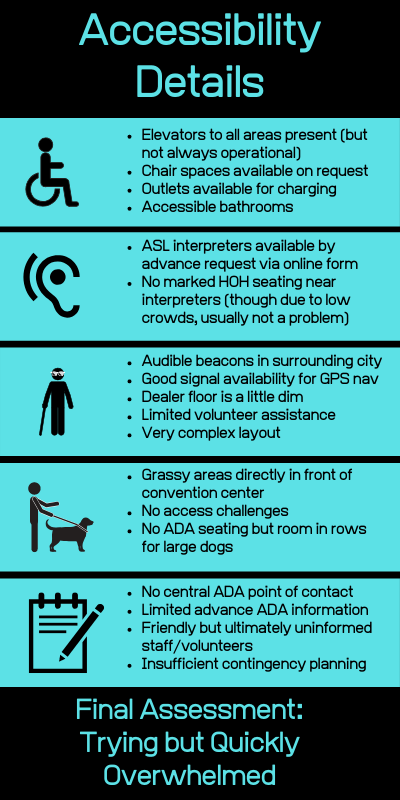 Accessibility Features
Accessibility Features
Baltimore Comic-Con didn’t seem to have much set up in the way of accessibility features. The staff met most of my questions with blank faces and usually replied with friendly but vague instructions to ask someone near the event rooms. (Those staff members seemed to solve everything on a case by case basis.)
There were ASL interpreters at the main stage events, and attendees could reserve time on a first-come, first-serve basis through an online form. Spontaneous visitors were out of luck, though, because I couldn’t find anyone who knew how to find out where the interpreters would be and how to see if one was free on-site.
When I did see the interpreters they were doing a credible job. However, the lack of dedicated ADA seating presented a problem. The Deaf and Hard of Hearing people in the audience had no obvious way to know where to sit to see the interpreters, and there wasn’t a camera on them like you see at some conventions.
Service dog handlers had a nice grassy area right out front for puppy downtime. The panel rooms had plenty of room for dogs in the aisles, though I found it easier to sit in front or at the side since I had so much choice.
I didn’t get any access challenges, either, just a polite “Is this a service dog and what tasks does he do?” on the way in. I really appreciate that. It demonstrates that they knew the laws and were taking some action to protect my working dog from fakers.
I did see a couple of other dogs inside. One -a pet under a table, not in a vest- growled at my service dog (who ignored him like a good boy). I would have been more comfortable if BCC had those service dog stickers you have to pick up on the way in like San Diego does. That’s not a perfect system, but at least it provides a higher level of screening.
The top floor was mostly quiet, with lots of sitting areas for those with sensory issues or who needed a break from the crowd. No one was guiding people there, but it was pretty obvious so that wasn’t needed.
I have to mention one thing which killed me on Sunday: the single elevator was out of order. There was only one sign on the door itself. ADA guests had to go all the way outside (in the rain, no less!) and around a corner to find another elevator. I wish they’d put a sign out front, or maybe right at the corner, so people didn’t have to trek through the rain twice.
Panelists
I looked for some panelists who used chairs or scooters to interview about how accessible the convention was for them. I wasn’t able to find any (awkward) and there wasn’t a central ADA representative on site. I’m basing this evaluation off talking to some exhibitors on the dealer floor as well as looking at the set-up in the meeting rooms.
The staff was disorganized but helpful to exhibitors with disabilities, especially during the set-up and tear down stages. An artist with a cane (who doesn’t want to be directly quoted) told me some staff members helped her carry boxes to her vehicle on Sunday when the elevator was out. That’s great.
What isn’t great is that I didn’t see any ramps to stages, or a lot of accessibility-oriented content. A lot of times those are lively and interesting panels that generate interesting discussions, so I was disappointed.
Convention Accessibility Summary:
Baltimore Comic-Con is at an awkward stage of growth. It’s big enough that the lack of attention to ADA needs was frustrating, but small enough that the “ask a volunteer, they’ll sort you out” policy seemed to work most of the time.
And things mostly did work out, most of the time. The biggest problem was the race, and (hopefully) that won’t be a problem every year.
I worry that stuff mostly working out is going to lead to complacency, though. Convention accessibility issues grow exponentially as a con scales up. What works at 15,000 guests falls apart well before 30,000.
The core problem is that BCC doesn’t have a scalable accessibility infrastructure in place. There’s not even an accessibility tab on their website. I checked, and even for 2020, there’s only a page for ASL service requests.
They need to sort out details like:
- Consultants to help identify and solve accessibility issues before the convention
- An ADA desk for information and assistance (or at least a section of a desk)
- Easily located ADA information on the website
- Obvious signage for ADA features
- More elevators (one? Seriously?)
- Alerts through social media about accessibility issues
- ASL interpreter schedules and on-site requests
- ADA seating, especially near the interpreters, or alternately a camera and screen setup
- Alternate plans for when accessibility features (like ELEVATORS) go out of order that include plenty of awareness measures
- Coaching for all volunteers and staff on common accessibility issues
As it stands I might go one more time, just to see if the race was the main cause of their problems. I was so tired, sore, and frustrated that it took me a month to come to that decision, though, and if I had friends with mobility issues I’d be cautious in recommending the con.
Final Grade: C- (because I’m generously excluding race-related issues but there was still ONE ELEVATOR)
Keep an eye out for The State of Convention Accessibility Part 2- MegaCon Orlando, coming soon!
Author: Khai
Khai is a writer, anthropologist, and games enthusiast. She is co-editor (alongside Alex DeCampi) of and contributor to “True War Stories”, a comic anthology published by Z2 Comics. When she’s not writing or creating games, Khai likes to run more tabletop RPGs than one person should reasonably juggle.
Help support independent journalism. Subscribe to our Patreon.
Copyright © The Geekiary
Do not copy our content in whole to other websites. If you are reading this anywhere besides TheGeekiary.com, it has been stolen.Read our

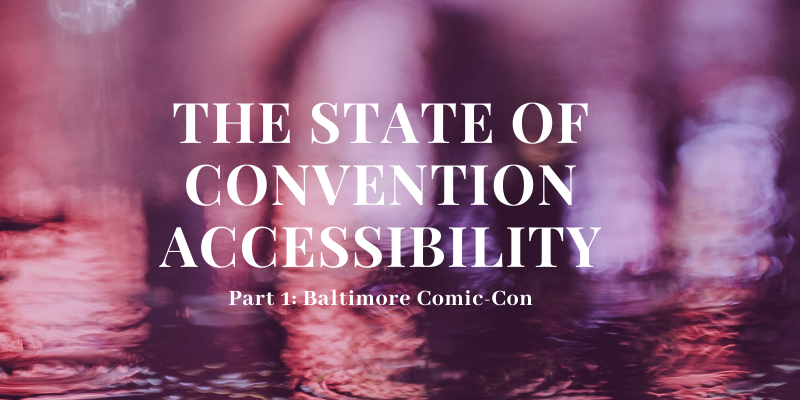

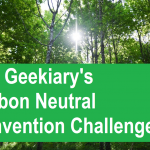
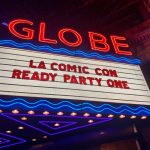
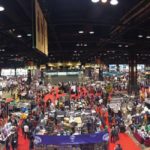


1 thought on “The State of Convention Accessibility- Part 1: Baltimore Comic-Con”
Comments are closed.